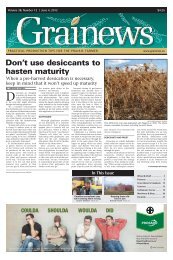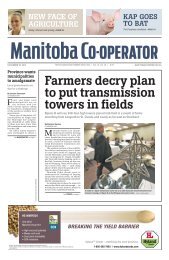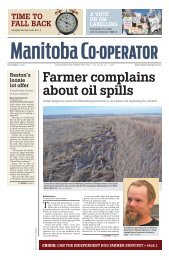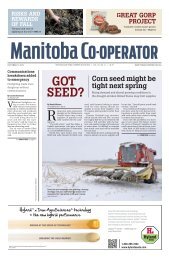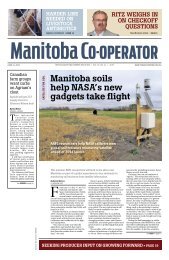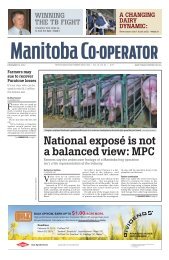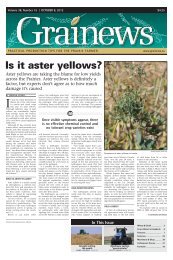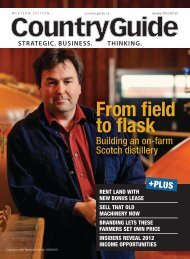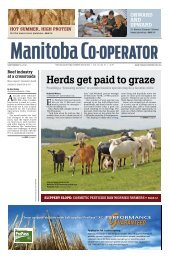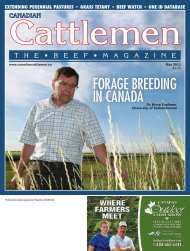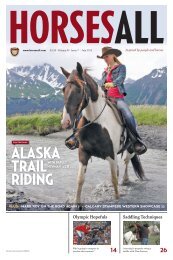Create successful ePaper yourself
Turn your PDF publications into a flip-book with our unique Google optimized e-Paper software.
The Manitoba Co-operator | July 12, 2012 7<br />
FLOOD WOES Continued from page 1<br />
Association held a joint press<br />
conference in the farm workshop<br />
of AVPA chair Stan<br />
Cochrane that was attended by<br />
about 30 farmers.<br />
KAP president Doug Chorney<br />
estimated that as many as<br />
40,000 acres of crops worth $16<br />
million along the Assiniboine, all<br />
the way from Lake of the Prairies<br />
to Brandon, is underwater due<br />
to mishandling of outflows from<br />
Shellmouth dam by provincial<br />
officials earlier this spring.<br />
“The producers in the valley<br />
that have been flooded out<br />
repeatedly cannot bear the burden<br />
and costs when decisions<br />
are made poorly,” said Chorney.<br />
Cochrane took issue with the<br />
province’s insistence that the<br />
decision earlier this spring to<br />
store water behind the dam 1.5<br />
feet above normal summer levels<br />
was the result of a consensus<br />
agreement by all downstream<br />
stakeholders that belong to the<br />
Shellmouth regulation liaison<br />
committee.<br />
“The Assiniboine valley producers<br />
never, at any time, told<br />
them that they should be closing<br />
the conduit,” he said, adding<br />
that due to high water tables, the<br />
group had in fact demanded that<br />
the level be drawn down ahead<br />
of spring rains.<br />
Instead, the province repeated<br />
the same mistake made in 2010,<br />
when outflows from the reservoir<br />
were curbed for almost two<br />
months, until heavy rains further<br />
up the Assiniboine watershed<br />
sent water pouring over the<br />
spillway unchecked.<br />
He added that so long as the<br />
Shellmouth Dam Act’s provision<br />
for 100 per cent compensation<br />
in cases of man-made flooding<br />
“left on a shelf,” redress for this<br />
spring’s blunder is unlikely.<br />
Keith Pearn, who farms 2,000<br />
acres upstream near Virden, said<br />
Manitoba Water Stewardship<br />
e x e c u t i ve d i re c t o r St e ve<br />
Topping’s told producer representatives<br />
on the committee that<br />
lowering the reservoir level “was<br />
not an option” because his staff<br />
were predicting a drought.<br />
“He chose to do what he did.<br />
It’s all his fault,” added Cochrane.<br />
“He can’t blame it on us.”<br />
A spokesman for the province<br />
said three weeks ago that<br />
Topping was travelling and<br />
couldn’t be reached by phone.<br />
Last week, the spokesperson<br />
said he was away on holiday.<br />
On May 28, officials were predicting<br />
only a 10 per cent chance<br />
that outflows would exceed 1,700<br />
cfs, even though they knew May<br />
rainfalls were already well above<br />
normal. In the end, control of<br />
outflows was lost when water<br />
started coming over the spillway.<br />
“Now, with outflows at over<br />
8,000 cfs, you can see the<br />
results,” added Pearn.<br />
“This is not a natural flood.<br />
The government chose to save<br />
water, and when they can’t<br />
hold it all in Shellmouth, they<br />
are using all of our land from<br />
Brandon to Shellmouth as their<br />
second reservoir.”<br />
Millwood-area rancher Cliff<br />
Trinder, who has studied the<br />
issue extensively after being<br />
flooded out over a dozen times<br />
since 2005, said that provincial<br />
officials are unaware of the<br />
changed dynamics of the watershed<br />
due to widespread drainage.<br />
The Upper Assiniboine watershed,<br />
which covers about five<br />
million acres of north-central<br />
Saskatchewan pothole country,<br />
Oak Lake-area farmer Leigh Smith stands next to his once promising field of flowering canola that now lies rotting under<br />
Assiniboine floodwaters. photo: Daniel Winters<br />
traditionally contributed only<br />
about three per cent of total<br />
flows on the Assiniboine.<br />
“Now, the precipitation com-<br />
ing down is about three times<br />
normal levels because of the<br />
drainage situation up there,”<br />
said Trinder.<br />
This is noT a<br />
Case ih sTeiger<br />
QuadTraC.<br />
It’s raw power in its purest form. It’s reliability painted<br />
too-much-time-in-the-sun red, and it only knows how to<br />
make hard work a little easier. It’s a powerful beast that’s<br />
always tough enough to get the job done, but never tough<br />
on fuel. No, this is not a tractor. It’s a provider. For you, yours<br />
and the rest of the planet. And you can get one from us.<br />
Introducing the new<br />
Rocky Mountain Equipment.<br />
dePendaBLe is WhaT We do.<br />
TAXI Canada InC<br />
CLIENT Rocky Mountain Equipment<br />
CREATED June 18/2012<br />
RMD121006AB_4_ManitobaC_Tractor.indd<br />
TRIM 8.125" x 10" CREATIVE filipe ACCOUNT Andrea<br />
LIVE MAC ARTIST yw PRODUCER leah f (ext. 238)<br />
The provincial spokesman<br />
said that April-to-June saw more<br />
than 200 mm of rain fall in the<br />
watershed area, and even with<br />
FROM PAGE ONE<br />
APPROVALS<br />
ARt diREctoR/dEsignER:<br />
wRitER<br />
MAc ARtist<br />
a lower drawdown of the reservoir,<br />
flooding would still have<br />
occurred. He added that the<br />
province will assess the issue of<br />
compensation.<br />
But Trinder accused provincial<br />
officials of cherry picking rainfall<br />
statistics from a monitoring<br />
station at Pelly, Sask., where a<br />
six-inch downpour fell, instead<br />
of presenting an average for the<br />
whole watershed.<br />
“Three miles down the road<br />
they had a quarter inch,” he<br />
said.<br />
On June 9, Trinder asked provincial<br />
experts to model what<br />
would have happened if the<br />
40-foot-deep reservoir had been<br />
lowered to 1,386 feet above<br />
sea level, and outflows kept at<br />
a constant 1,500 cfs, instead<br />
of the 1,403.5 target – just five<br />
feet below the spillway level of<br />
1,408.5 – set this spring.<br />
Officials responded to his<br />
request by saying they “didn’t<br />
have time to do it,” said<br />
Trinder.<br />
daniel.winters@fbcpublishing.com





